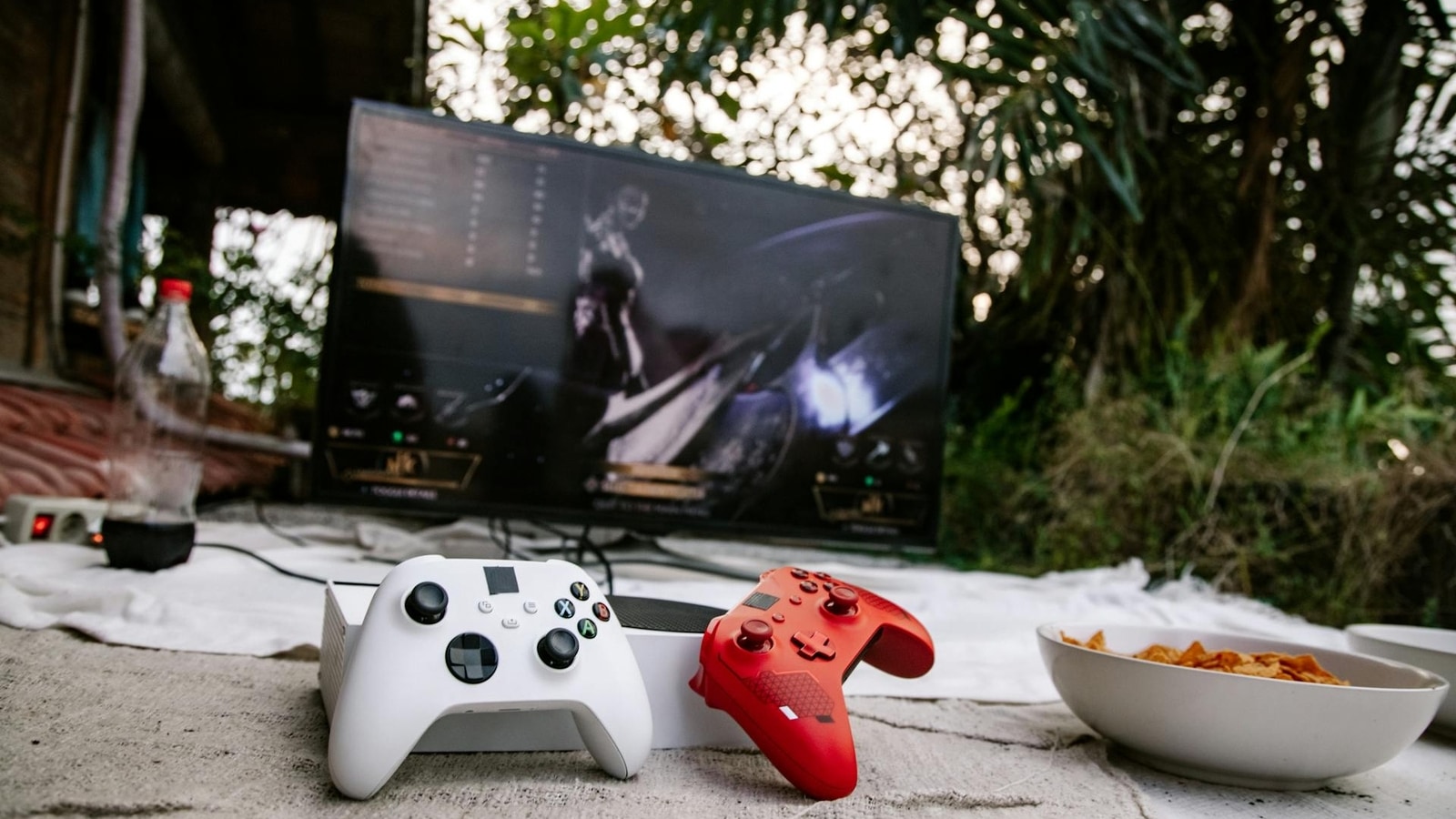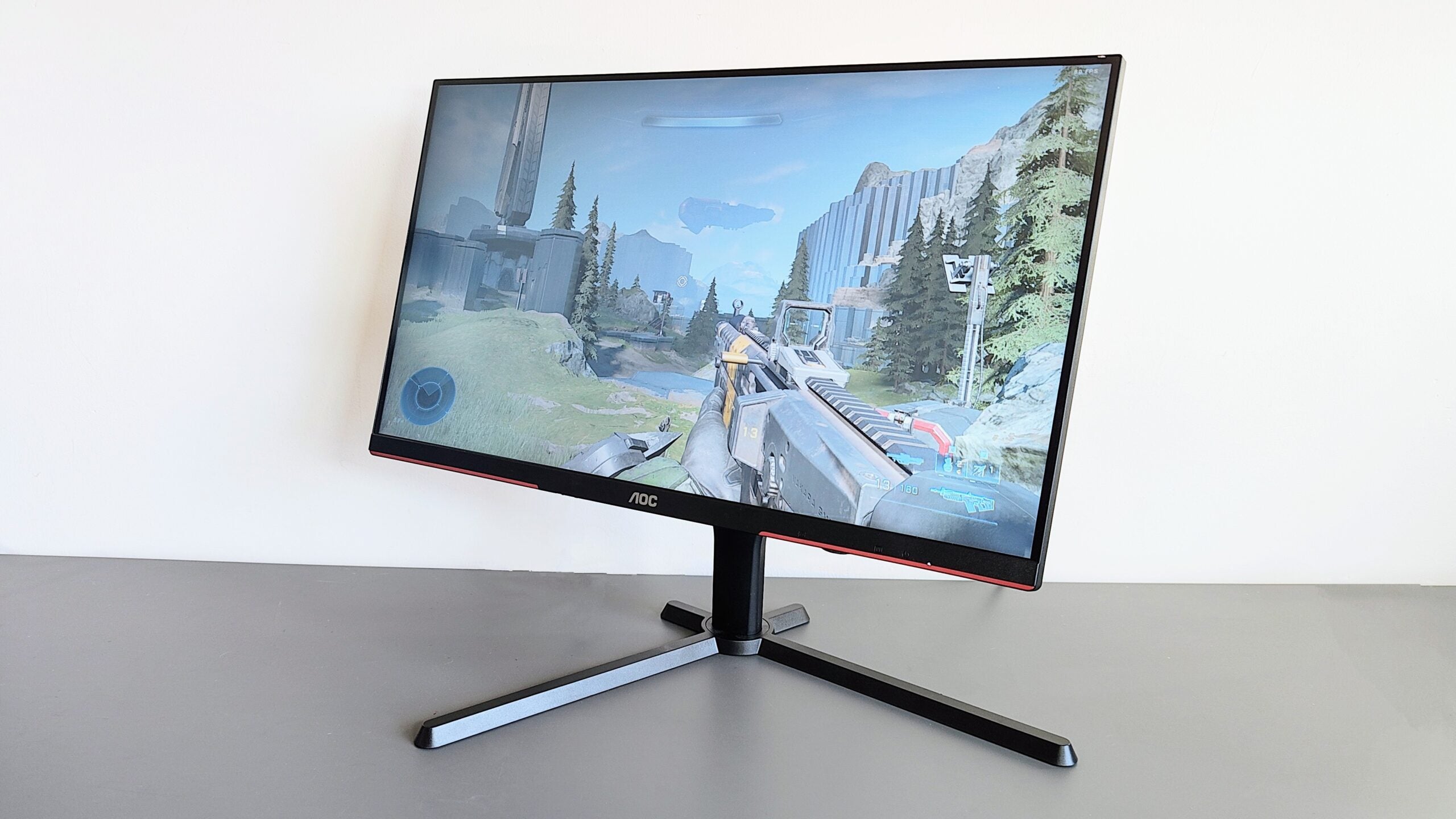Verdict
The AOC Gaming 25G3ZM/BK ticks a lot of boxes. Any monitor that offers a 240Hz refresh rate, a near 4000:1 contrast ratio and costs less than £200 has to be worth consideration. It is spectacular value for money.
Pros
- 240Hz refresh rate
- Exceptional value
- Impressive colour accuracy
- Strong colour gamut coverage
Cons
- Some visible ghosting
- No USB connectivity
- Could be brighter
- HDMI and DP connectors not latest spec
Introduction
The 25G3ZM/BK may be the second-cheapest model in the AOC Gaming range but the model below it is a very basic 165Hz 23.8–inch IPS affair. The AOC Gaming 25G3ZM/BK is bigger, faster and uses a VA panel which, at the lower end of the gaming market, is definitely what you want to go for.
AOC’s gaming monitors come in three categories, AOC Gaming is the entry-level series, above it sits the more expensive Agon and the more expensive again Agon Pro ranges. The 25G3ZM/BK is the former and can be picked up for under £180. When you consider that the very cheapest basic monitors, like Huawei’s excellent MateView SE, set you back just £30 or £40 less than this machine, the budget gaming AOC is outstanding value for money.
And you get a fair bit for your money. The display may be a basic 1920 x 1080 resolution flat panel but it refreshes at 240Hz and it’s a very competent VA (Vertical Alignment) affair, coming packed with all the user–adjustability that serious gamers demand for ultimate optimisation. A podium in the Best Monitor Hall of Fame may well beckon.
Design and Features
- Compact design with narrow bezels
- No USB ports
- No speakers
AOC has done a good job of not making the 25G3ZM/BK look or feel as cheap as it is. The black plastic stand and bodywork feel reassuringly solid. The red plastic applique on the back and bottom of the monitor, as well as the stand, add a certain visual flair to proceedings.
The design is described as “three–sided frameless” which means that the top and side bezels are a slender 6mm, so you won’t see much black plastic between two of these monitors if you run them side–by–side. The strip below the monitor is taller at 18mm, but that’s still not too obtrusive.
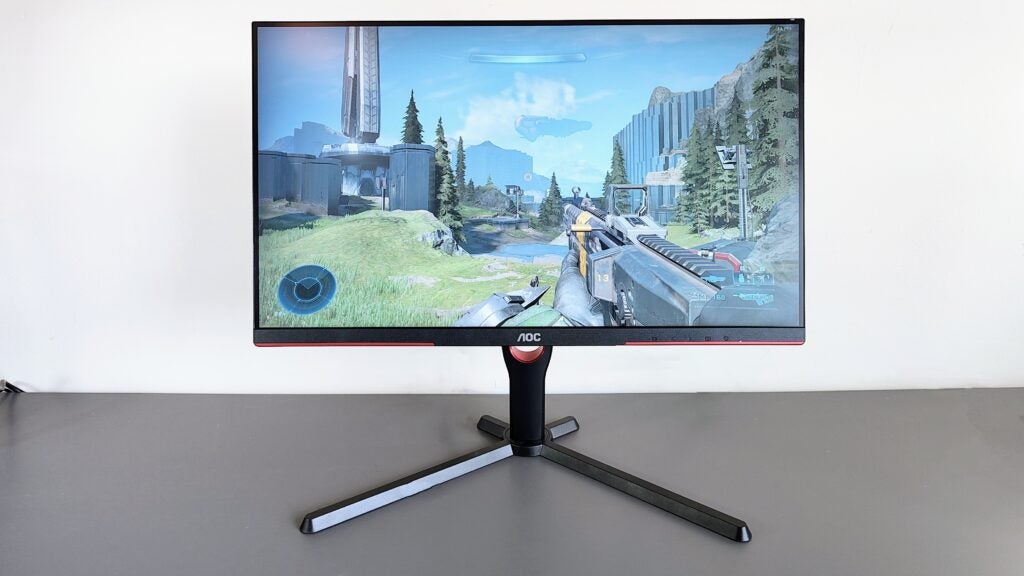
As you might expect, for this sort of money, there’s no RGB light show, no USB connectivity and no loudspeakers. Look around the back and the only ports you’ll find are two HDMI 2.0 and one DisplayPort 1.2 for video input, then a 3.5mm audio jack to connect to a set of speakers or headphones.
The display supports adaptive sync between 48Hz and 240Hz and though it only has official AMD FreeSync Premium certification Nvidia’s G–Sync worked perfectly when connected to an RTX 3060 GPU.
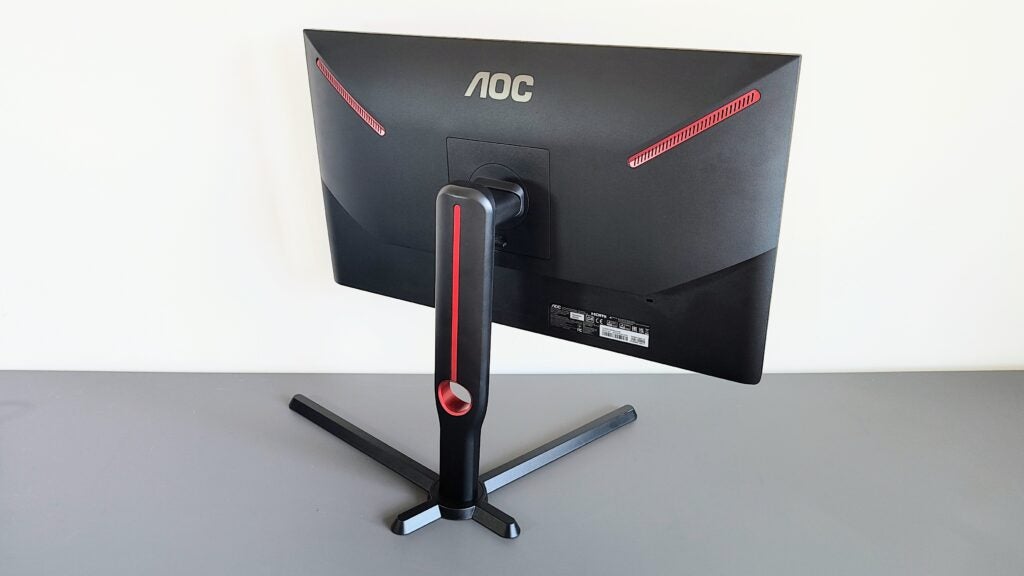
The stand is a simple but slender affair, with a large circle cut out through which you can thread the power and video cables in the name of tidiness. More important is the 90° left and right pivot which makes it ideal for scrolling shooters or as a secondary display. There’s also 130mm of height adjustment, 30° of left and right swivel and -5/23° of tilt. The lovely thing about displays this big is they don’t weigh much, in this case just 4.25Kg all–in.
The onscreen menu system is comprehensive, with all the expected gaming colour and motion settings present and correct. There’s also a frame rate counter, crosshairs and dark boost to make things lurking in dark corners more easily seen.
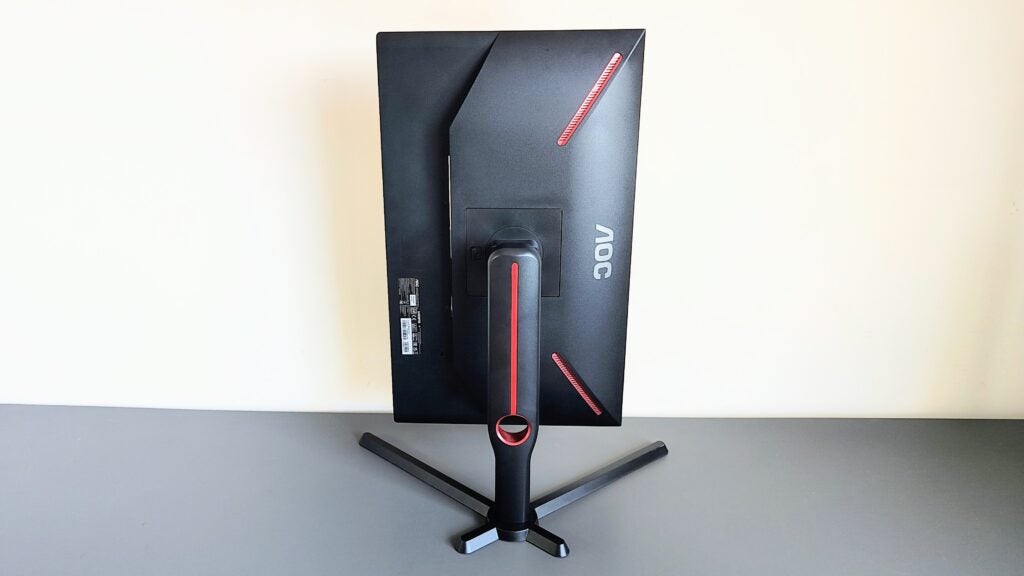
The menu layout looks rather dated and the four–button navigation system works well enough in well–lit rooms. However, the black–on–black icons and the absence of any onscreen indications of what you need to push in any given context make it a pain to use in the dark.
Incidentally, like many AOC gaming monitors, there’s a menu option to engage low input lag mode. Why that isn’t an always–on feature is beyond me, but once switched on the AOC Gaming 25G3ZM/BK reacts with lightning speed.
Image Quality
- Solid gamut coverage
- Impressive contrast ratio
- Some ghosting visible
The 25G3ZM/BK uses a VA panel, which displays all the expected strengths of that technology, such as a high contrast ratio of nearly 4,000:1. That’s more to do with the low black luminescence level of just 0.08cd/m2 rather than the maximum brightness level of 318cd/m2, which is nothing to get too excited about.
Viewing angles are generally regarded as the Achilles’ heel of VA screens but AOC credits the 25G3ZM/BK with maximum viewing angles of 178°. That’s what most manufacturers claim for their IPS panels and I’d have to agree. Even at extreme viewing angles, there was no chromatic shift in evidence.
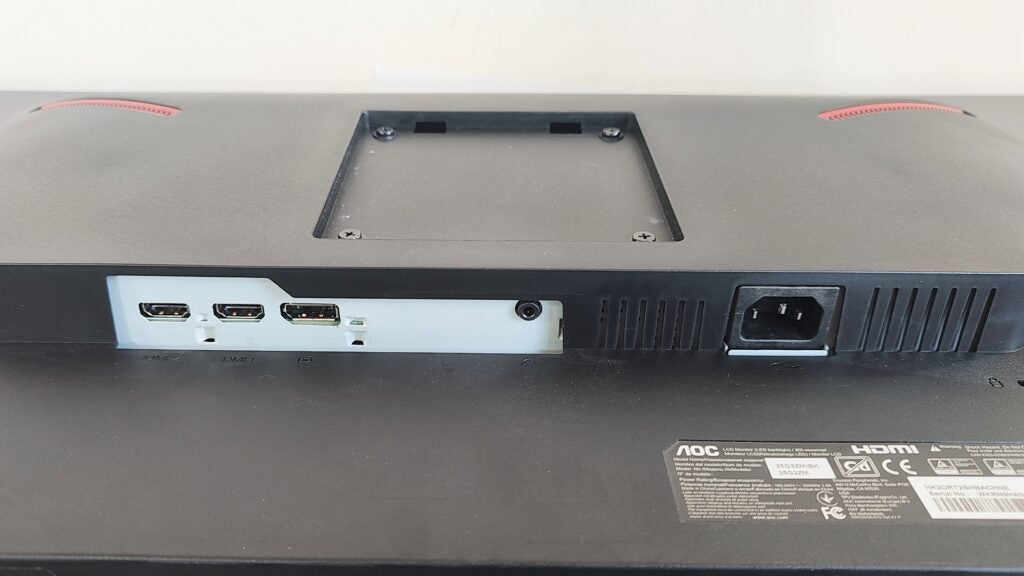
There’s a useful amount of colour to be seen with 99.7% of the sRGB gamut accounted for, along with 91.2% DCI–P3 and 80.8% AdobeRGB. For a sub–£200 gaming monitor that is a very, very impressive set of numbers.
Apart from the usual game type-specific colour profiles, such as FPS, RTS, Racing and the like, there is also an sRGB clamp. If you engage it, the maximum brightness is limited to 120cd/m2 though. Measuring the Delta E colour accuracy against sRGB resulted in an impressively low figure of just 1.5. Out of curiosity, I changed the colour mode to Normal and measured the Delta E against the DCI–P3 profile and the figure only jumped to 1.76. This is still comfortably below 2, the level at which only a trained eye may start to detect any variance.
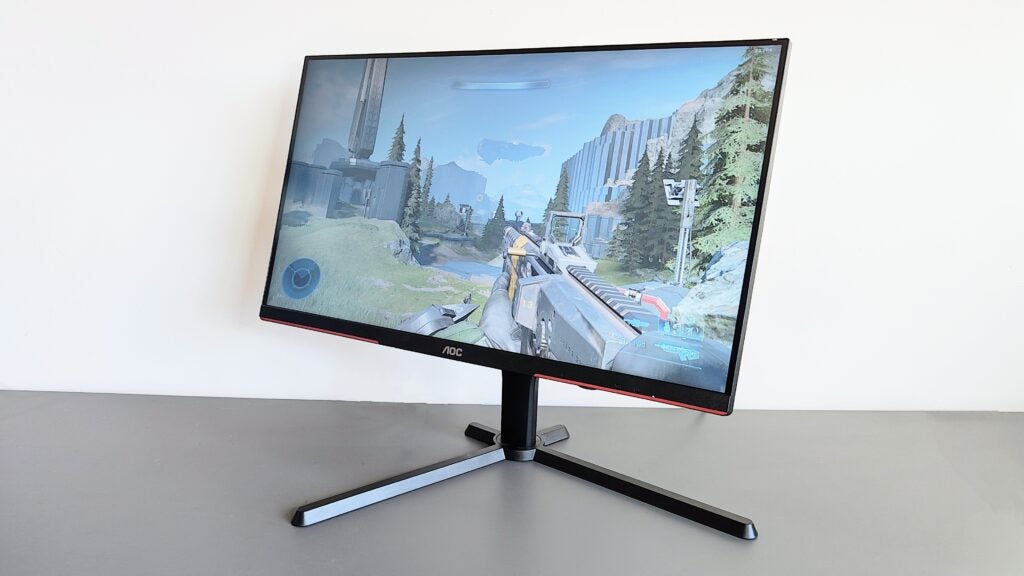
There’s nothing wrong with the panel’s uniformity either. Testing for lighting variations, only the very far right of the screen failed to fall within the recommended tolerance but it was still comfortably inside nominal tolerances. The slight dip in brightness is imperceptible unless you check it with a colourimeter. Backlight bleed is seldom an issue with VA panels and the AOC Gaming 25G3ZM/BK performed perfectly, with no light bleed at the edges whatsoever.
AOC credits the 25G3ZM/BK with a GtG response time of 1ms and an MPRT of 0.5ms. Looking at the standard UFO test, those figures are a little optimistic (as they all too often are with gaming monitors) because there is some ghosting to be seen.
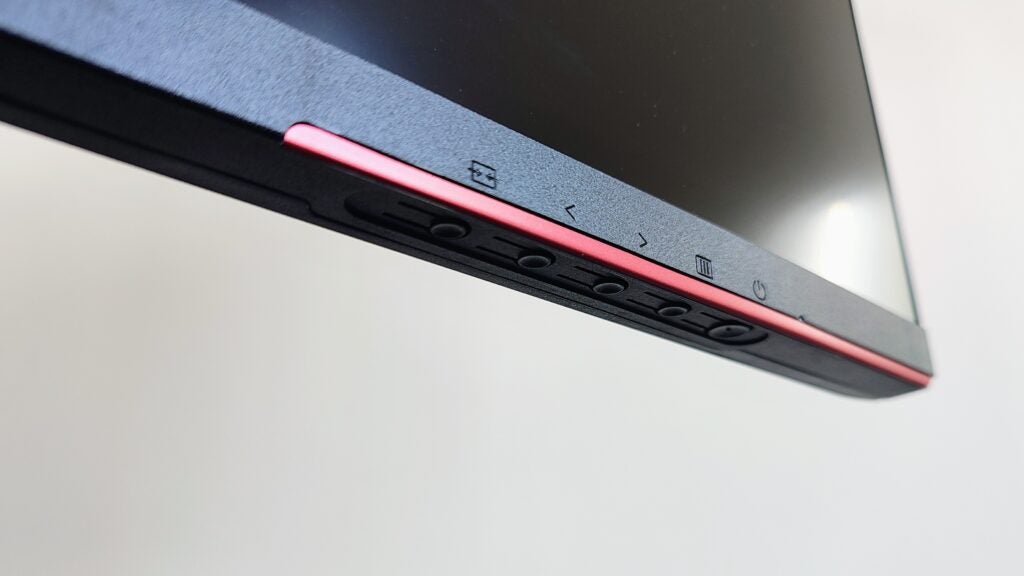
The AOC Gaming 25G3ZM/BK has a four–level overdrive but in Weak mode, it has little impact on ghosting and, though things improve when you move up to Medium, some ghosting is still noticeable on test screens. Upping the overdrive again to Strong reduced ghosting further but added some overcorrection so that inverse ghosting became visible. The final setting, Boost, is a small improvement over Strong but it severely restricts the maximum brightness.
Medium is clearly the setting to choose for general gaming, but the level of ghosting is the one area of performance where you’ll notice that you are using a cheaper monitor. I spent several hours playing Apex Legends and Counter–Strike: Global Offensive with overdrive set to Strong and the inverse ghosting there was didn’t distract me.
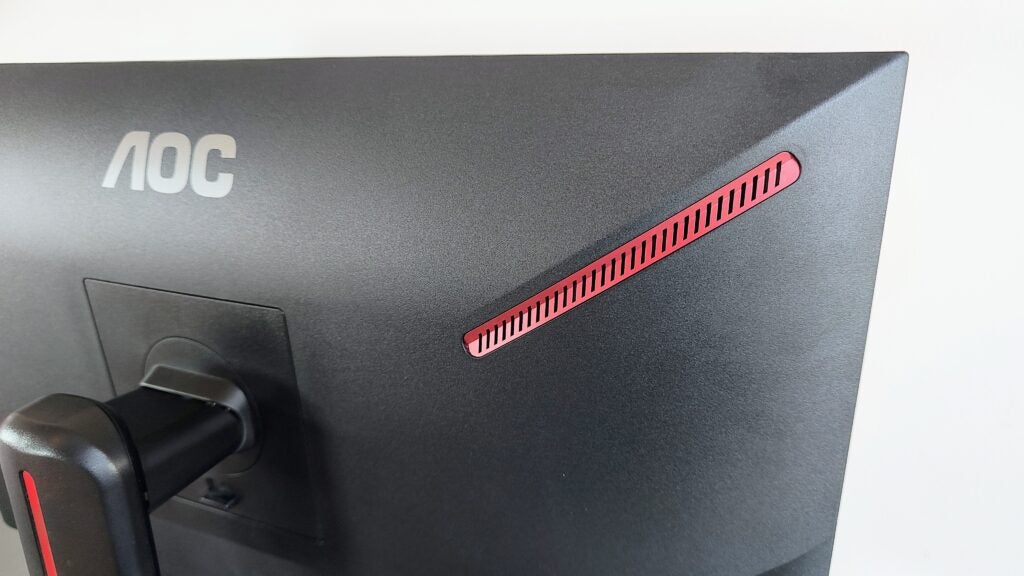
There is also a 20–level MBR or Motion Blur Reduction adjuster that sharpens moving images, but the higher you push it, the lower the maximum brightness until you are limited to a very low 40cd/m2 which reduces its usability unless you are gaming in a darkened room.
The AOC Gaming 25G3ZM/BK doesn’t offer anything in the way of HDR support but that high contrast ratio and high gamut coverage mean that good–quality video is still pretty impressive.
Latest deals
Should you buy it?
This AOC monitor packs a lot of gaming ability for very little money
When you are getting the levels of speed, colour and colour accuracy that the AOC Gaming 25G3ZM/BK delivers along with a fair bit of change from £200 it’s churlish in the extreme to not regard it as an absolute bargain. There are of course better gaming monitors on the market but you need to spend quite a bit more to get one.
The cheap price is reflected in the entry-level connectivity
The physical specification is rather rudimentary: There’s no Type–C input, no USB connectivity, the video inputs are not the latest spec so you miss VRR support with the latest generation consoles, and there are no loudspeakers.
Final Thoughts
Cheap gaming monitors, and by cheap I mean anything with a price ticket less than £250 are pretty thin on the ground so there’s nothing that we’ve looked at recently here at Trusted Reviews to directly compare to this new AOC budget gamer. If you’re willing to spend a bit more for more features and swankier technology, check out our best gaming monitors guide.
Granted the 25G3ZM/BK has some faults such as limited connectivity and rather more ghosting than I prefer to see on a gaming display but I have to keep reminding myself that this is a £180 monitor. To get a gaming monitor with a 240Hz refresh rate with better motion handling and better connectivity would involve spending a considerably larger amount of cash. Add the underlying technical competence of the 25G3ZM/BK’s panel in terms of colour registration and accuracy into the mix and you really are getting way more than your money’s worth.
How we test
We use every monitor we test for at least a week. During that time, we’ll check it for ease of use and put it through its paces by using it for both everyday tasks and extended gaming sessions
We also check its colours and image quality with a colorimeter to test its coverage and the display’s quality.
FAQs
Yes. It has very solid colour gamut coverage and it is surprisingly colour accurate for a cheap display, let alone a cheap gaming display. The VA panel has a great contrast ratio and the maximum brightness isn’t too shabby either. I like the space–efficient and widely adjustable stand too and the slim bezels mean you can put two side–by–side which at the price isn’t an expensive undertaking.
Yes. The truly hardcore may demand a 360Hz refresh rate but, for the rest of us, mere mortals 240Hz is more than adequate. The 25G3ZM comes with a plethora of adjustment options for motion handling and colour management and three user-savable preset options, something you don’t find on a lot of gaming monitors no matter what the price.
Trusted Reviews test data
Verdict
The AOC Gaming 25G3ZM/BK ticks a lot of boxes. Any monitor that offers a 240Hz refresh rate, a near 4000:1 contrast ratio and costs less than £200 has to be worth consideration. It is spectacular value for money.
Pros
- 240Hz refresh rate
- Exceptional value
- Impressive colour accuracy
- Strong colour gamut coverage
Cons
- Some visible ghosting
- No USB connectivity
- Could be brighter
- HDMI and DP connectors not latest spec
Introduction
The 25G3ZM/BK may be the second-cheapest model in the AOC Gaming range but the model below it is a very basic 165Hz 23.8–inch IPS affair. The AOC Gaming 25G3ZM/BK is bigger, faster and uses a VA panel which, at the lower end of the gaming market, is definitely what you want to go for.
AOC’s gaming monitors come in three categories, AOC Gaming is the entry-level series, above it sits the more expensive Agon and the more expensive again Agon Pro ranges. The 25G3ZM/BK is the former and can be picked up for under £180. When you consider that the very cheapest basic monitors, like Huawei’s excellent MateView SE, set you back just £30 or £40 less than this machine, the budget gaming AOC is outstanding value for money.
And you get a fair bit for your money. The display may be a basic 1920 x 1080 resolution flat panel but it refreshes at 240Hz and it’s a very competent VA (Vertical Alignment) affair, coming packed with all the user–adjustability that serious gamers demand for ultimate optimisation. A podium in the Best Monitor Hall of Fame may well beckon.
Design and Features
- Compact design with narrow bezels
- No USB ports
- No speakers
AOC has done a good job of not making the 25G3ZM/BK look or feel as cheap as it is. The black plastic stand and bodywork feel reassuringly solid. The red plastic applique on the back and bottom of the monitor, as well as the stand, add a certain visual flair to proceedings.
The design is described as “three–sided frameless” which means that the top and side bezels are a slender 6mm, so you won’t see much black plastic between two of these monitors if you run them side–by–side. The strip below the monitor is taller at 18mm, but that’s still not too obtrusive.

As you might expect, for this sort of money, there’s no RGB light show, no USB connectivity and no loudspeakers. Look around the back and the only ports you’ll find are two HDMI 2.0 and one DisplayPort 1.2 for video input, then a 3.5mm audio jack to connect to a set of speakers or headphones.
The display supports adaptive sync between 48Hz and 240Hz and though it only has official AMD FreeSync Premium certification Nvidia’s G–Sync worked perfectly when connected to an RTX 3060 GPU.

The stand is a simple but slender affair, with a large circle cut out through which you can thread the power and video cables in the name of tidiness. More important is the 90° left and right pivot which makes it ideal for scrolling shooters or as a secondary display. There’s also 130mm of height adjustment, 30° of left and right swivel and -5/23° of tilt. The lovely thing about displays this big is they don’t weigh much, in this case just 4.25Kg all–in.
The onscreen menu system is comprehensive, with all the expected gaming colour and motion settings present and correct. There’s also a frame rate counter, crosshairs and dark boost to make things lurking in dark corners more easily seen.

The menu layout looks rather dated and the four–button navigation system works well enough in well–lit rooms. However, the black–on–black icons and the absence of any onscreen indications of what you need to push in any given context make it a pain to use in the dark.
Incidentally, like many AOC gaming monitors, there’s a menu option to engage low input lag mode. Why that isn’t an always–on feature is beyond me, but once switched on the AOC Gaming 25G3ZM/BK reacts with lightning speed.
Image Quality
- Solid gamut coverage
- Impressive contrast ratio
- Some ghosting visible
The 25G3ZM/BK uses a VA panel, which displays all the expected strengths of that technology, such as a high contrast ratio of nearly 4,000:1. That’s more to do with the low black luminescence level of just 0.08cd/m2 rather than the maximum brightness level of 318cd/m2, which is nothing to get too excited about.
Viewing angles are generally regarded as the Achilles’ heel of VA screens but AOC credits the 25G3ZM/BK with maximum viewing angles of 178°. That’s what most manufacturers claim for their IPS panels and I’d have to agree. Even at extreme viewing angles, there was no chromatic shift in evidence.

There’s a useful amount of colour to be seen with 99.7% of the sRGB gamut accounted for, along with 91.2% DCI–P3 and 80.8% AdobeRGB. For a sub–£200 gaming monitor that is a very, very impressive set of numbers.
Apart from the usual game type-specific colour profiles, such as FPS, RTS, Racing and the like, there is also an sRGB clamp. If you engage it, the maximum brightness is limited to 120cd/m2 though. Measuring the Delta E colour accuracy against sRGB resulted in an impressively low figure of just 1.5. Out of curiosity, I changed the colour mode to Normal and measured the Delta E against the DCI–P3 profile and the figure only jumped to 1.76. This is still comfortably below 2, the level at which only a trained eye may start to detect any variance.

There’s nothing wrong with the panel’s uniformity either. Testing for lighting variations, only the very far right of the screen failed to fall within the recommended tolerance but it was still comfortably inside nominal tolerances. The slight dip in brightness is imperceptible unless you check it with a colourimeter. Backlight bleed is seldom an issue with VA panels and the AOC Gaming 25G3ZM/BK performed perfectly, with no light bleed at the edges whatsoever.
AOC credits the 25G3ZM/BK with a GtG response time of 1ms and an MPRT of 0.5ms. Looking at the standard UFO test, those figures are a little optimistic (as they all too often are with gaming monitors) because there is some ghosting to be seen.

The AOC Gaming 25G3ZM/BK has a four–level overdrive but in Weak mode, it has little impact on ghosting and, though things improve when you move up to Medium, some ghosting is still noticeable on test screens. Upping the overdrive again to Strong reduced ghosting further but added some overcorrection so that inverse ghosting became visible. The final setting, Boost, is a small improvement over Strong but it severely restricts the maximum brightness.
Medium is clearly the setting to choose for general gaming, but the level of ghosting is the one area of performance where you’ll notice that you are using a cheaper monitor. I spent several hours playing Apex Legends and Counter–Strike: Global Offensive with overdrive set to Strong and the inverse ghosting there was didn’t distract me.

There is also a 20–level MBR or Motion Blur Reduction adjuster that sharpens moving images, but the higher you push it, the lower the maximum brightness until you are limited to a very low 40cd/m2 which reduces its usability unless you are gaming in a darkened room.
The AOC Gaming 25G3ZM/BK doesn’t offer anything in the way of HDR support but that high contrast ratio and high gamut coverage mean that good–quality video is still pretty impressive.
Latest deals
Should you buy it?
This AOC monitor packs a lot of gaming ability for very little money
When you are getting the levels of speed, colour and colour accuracy that the AOC Gaming 25G3ZM/BK delivers along with a fair bit of change from £200 it’s churlish in the extreme to not regard it as an absolute bargain. There are of course better gaming monitors on the market but you need to spend quite a bit more to get one.
The cheap price is reflected in the entry-level connectivity
The physical specification is rather rudimentary: There’s no Type–C input, no USB connectivity, the video inputs are not the latest spec so you miss VRR support with the latest generation consoles, and there are no loudspeakers.
Final Thoughts
Cheap gaming monitors, and by cheap I mean anything with a price ticket less than £250 are pretty thin on the ground so there’s nothing that we’ve looked at recently here at Trusted Reviews to directly compare to this new AOC budget gamer. If you’re willing to spend a bit more for more features and swankier technology, check out our best gaming monitors guide.
Granted the 25G3ZM/BK has some faults such as limited connectivity and rather more ghosting than I prefer to see on a gaming display but I have to keep reminding myself that this is a £180 monitor. To get a gaming monitor with a 240Hz refresh rate with better motion handling and better connectivity would involve spending a considerably larger amount of cash. Add the underlying technical competence of the 25G3ZM/BK’s panel in terms of colour registration and accuracy into the mix and you really are getting way more than your money’s worth.
How we test
We use every monitor we test for at least a week. During that time, we’ll check it for ease of use and put it through its paces by using it for both everyday tasks and extended gaming sessions
We also check its colours and image quality with a colorimeter to test its coverage and the display’s quality.
FAQs
Yes. It has very solid colour gamut coverage and it is surprisingly colour accurate for a cheap display, let alone a cheap gaming display. The VA panel has a great contrast ratio and the maximum brightness isn’t too shabby either. I like the space–efficient and widely adjustable stand too and the slim bezels mean you can put two side–by–side which at the price isn’t an expensive undertaking.
Yes. The truly hardcore may demand a 360Hz refresh rate but, for the rest of us, mere mortals 240Hz is more than adequate. The 25G3ZM comes with a plethora of adjustment options for motion handling and colour management and three user-savable preset options, something you don’t find on a lot of gaming monitors no matter what the price.








